Analysis of E-Scooter Crashes in the City of Bari
Abstract
:1. Introduction
2. Methodology
2.1. Data Collection
2.2. Study Variables
- Injury severity: No, Yes.
- Road category: Undivided two-way, Undivided one-way, Divided multi-lane, Pedestrian zone.
- Day hour: Calm hours, Peak hour, Night hours.
- Week day: Weekday, Weekend and Holiday (including Sundays).
- Season: Summer, Autumn, Winter, Spring.
- Road Geometry: Segment (including bridges, tunnels), Unsignalized intersection, Signalized intersection, Roundabout.
- Crash Type: Single-vehicle, Angle, Sideswipe, Pedestrian hit, Other.
- Pavement: Dry, Wet/Slippery.
- Age: <18, 18–30, 31–40, >40, Unspecified.
- Sex: Man, Woman, Unspecified.
- Passengers: No, Yes, Unspecified.
- Sharing: Private, Sharing, Unspecified.
- Dynamics: Crash not caused by the e-scooter, Irregular e-scooter behavior, Other, Road surface issues.
- Crash on a cycle path: No, Yes, Unspecified.
- Presence of cycle paths: No, Yes.
2.3. Statistical Methods
- A binary logit model, having the injury severity as independent variable (injuries: yes or no) and the other above defined crash-related variables as potential predictors;
- A multinomial logit model, having the crash type as independent variable (single-vehicle as the reference type, other types: angle, sideswipe, pedestrian hit, and other crashes) and the other above defined crash-related variables as potential predictors.
- crash type;
- = i-th independent variable;
- = i-th coefficient ( is the intercept) associated with the j-th crash type chosen among the set of alternative m crash types.
3. Results
3.1. Results from the Descriptive Analysis
3.2. Results of the Statistical Models
4. Discussion
5. Conclusions
Author Contributions
Funding
Data Availability Statement
Acknowledgments
Conflicts of Interest
References
- Baek, K.; Lee, H.; Chung, J.H.; Kim, J. Electric scooter sharing: How do people value it as a last-mile transportation mode? Transp. Res. Part D Transp. Environ. 2021, 90, 102642. [Google Scholar] [CrossRef]
- McQueen, M.; Clifton, K.J. Assessing the perception of E-scooters as a practical and equitable first-mile/last-mile solution. Transp. Res. Part A Policy Pract. 2022, 165, 395–418. [Google Scholar] [CrossRef]
- Zuniga-Garcia, N.; Tec, M.; Scott, J.G.; Machemehl, R.B. Evaluation of e-scooters as transit last-mile solution. Transp. Res. Part C Emerg. Technol. 2022, 139, 103660. [Google Scholar] [CrossRef]
- Kazemzadeh, K.; Haghani, M.; Sprei, F. Electric scooter safety: An integrative review of evidence from transport and medical research domains. Sustain. Cities Soc. 2022, 89, 104313. [Google Scholar] [CrossRef]
- Liu, M.; Seeder, S.; Li, H. Analysis of e-scooter trips and their temporal usage patterns. Inst. Transp. Eng. ITE J. 2019, 89, 44–49. [Google Scholar]
- Glavić, D.; Trpković, A.; Milenković, M.; Jevremović, S. The E-Scooter Potential to Change Urban Mobility—Belgrade Case Study. Sustainability 2021, 13, 5948. [Google Scholar] [CrossRef]
- Latinopoulos, C.; Patrier, A.; Sivakumar, A. Planning for e-scooter use in metropolitan cities: A case study for Paris. Transp. Res. Part D Transp. Environ. 2021, 100, 103037. [Google Scholar] [CrossRef]
- Mclean, R.; Williamson, C.; Kattan, L. Simulation Modeling of Urban E-Scooter Mobility. In Proceedings of the 2021 29th International Symposium on Modeling, Analysis, and Simulation of Computer and Telecommunication Systems (MASCOTS), Houston, TX, USA, 3–5 November 2021; IEEE: Piscataway, NJ, USA, 2021; pp. 1–8. [Google Scholar]
- Feng, C.; Jiao, J.; Wang, H. Estimating e-scooter traffic flow using big data to support planning for micromobility. J. Urban Technol. 2022, 29, 139–157. [Google Scholar] [CrossRef]
- Laa, B.; Leth, U. Survey of E-scooter users in Vienna: Who they are and how they ride. J. Transp. Geogr. 2020, 89, 102874. [Google Scholar] [CrossRef]
- Sanders, R.L.; Branion-Calles, M.; Nelson, T.A. To scoot or not to scoot: Findings from a recent survey about the benefits and barriers of using E-scooters for riders and non-riders. Transp. Res. Part A Policy Pract. 2020, 139, 217–227. [Google Scholar] [CrossRef]
- Cloud, C.; Heß, S.; Kasinger, J. Do shared e-scooter services cause traffic crashes? Evidence from six European countries. arXiv 2022, arXiv:2209.06870. [Google Scholar]
- Karpinski, E.; Bayles, E.; Daigle, L.; Mantine, D. Comparison of motor-vehicle involved e-scooter fatalities with other traffic fatalities. J. Saf. Res. 2024, 84, 61–73. [Google Scholar] [CrossRef]
- Kelly, C.; O’Hare, C.; Ceannt, R.; O’Mahony, M.; Kelly, I.; McDermott, R.; Kiernan, R. An Analysis of E-Scooter Related Trauma. Ir. Med. J. 2022, 115, P642. [Google Scholar]
- Bieliński, T.; Ważna, A. Electric scooter sharing and bike sharing user behaviour and characteristics. Sustainability 2020, 12, 9640. [Google Scholar] [CrossRef]
- D’andreagiovanni, F.; Nardin, A.; Carrese, S. An Analysis of the Service Coverage and Regulation of E-Scooter Sharing in Rome (Italy). Transp. Res. Procedia 2022, 60, 440–447. [Google Scholar] [CrossRef]
- Pazzini, M.; Cameli, L.; Lantieri, C.; Vignali, V.; Dondi, G.; Jonsson, T. New means of transport for micro-mobility: An analysis of electric scooter users’ behaviour in Trondheim. Int. J. Environ. Res. Public Health 2022, 19, 7374. [Google Scholar] [CrossRef] [PubMed]
- Huemer, A.K.; Banach, E.; Bolten, N.; Helweg, S.; Koch, A.; Martin, T. Secondary task engagement, risk-taking, and safety-related equipment use in German bicycle and e-scooter riders—An observation. Crash Anal. Prev. 2022, 172, 106685. [Google Scholar] [CrossRef] [PubMed]
- Prencipe, L.P.; Colovic, A.; De Bartolomeo, S.; Caggiani, L.; Ottomanelli, M. An efficiency indicator for micromobility safety assessment. In Proceedings of the 2022 IEEE International Conference on Environment and Electrical Engineering and 2022 IEEE Industrial and Commercial Power Systems Europe (EEEIC/I&CPS Europe), Prague, Czech Republic, 28 June–1 July 2022; IEEE: Piscataway, NJ, USA, 2022; pp. 1–6. [Google Scholar]
- Li, T.; Kovaceva, J.; Dozza, M. Modeling collision avoidance maneuvers for micromobility vehicles. J. Saf. Res. 2023, 87, 232–243. [Google Scholar] [CrossRef] [PubMed]
- Vetturi, D.; Tiboni, M.; Maternini, G.; Barabino, B.; Ventura, R. Kinematic performance of micro-mobility vehicles during braking: Experimental analysis and comparison between e-kick scooters and bikes. Transp. Res. Procedia 2023, 69, 408–415. [Google Scholar] [CrossRef]
- Ventura, R.; Ghirardi, A.; Vetturi, D.; Maternini, G.; Barabino, B. Comparing the vibrational behaviour of e-kick scooters and e-bikes: Evidence from Italy. Int. J. Transp. Sci. Technol. 2023, in press. [Google Scholar] [CrossRef]
- Vella, A.D.; Digo, E.; Gastaldi, L.; Pastorelli, S.; Vigliani, A. Statistical Analysis of the Vibrations Transmitted from an Electric Kick Scooter to Riders. Exp. Tech. 2024, 1–11. [Google Scholar] [CrossRef]
- Brownson, A.B.; Fagan, P.V.; Dickson, S.; Civil, I.D. Electric scooter injuries at Auckland City Hospital. N. Z. Med. J. 2019, 132, 62–72. [Google Scholar]
- Stigson, H.; Malakuti, I.; Klingegård, M. Electric scooters accidents: Analyses of two Swedish accident data sets. Accid. Anal. Prev. 2021, 163, 106466. [Google Scholar] [CrossRef]
- Brunner, P.; Löcken, A.; Denk, F.; Kates, R.; Huber, W. Analysis of experimental data on dynamics and behaviour of e-scooter riders and applications to the impact of automated driving functions on urban road safety. In Proceedings of the 2020 IEEE Intelligent Vehicles Symposium (IV), Las Vegas, NV, USA, 19 October–13 November 2020; IEEE: Piscataway, NJ, USA, 2020; pp. 219–225. [Google Scholar]
- Ptak, M.; Fernandes, F.A.; Dymek, M.; Welter, C.; Brodziński, K.; Chybowski, L. Analysis of electric scooter user kinematics after a crash against SUV. PLoS ONE 2022, 17, e0262682. [Google Scholar] [CrossRef]
- Sun, Y.; Lu, J.; Ren, G.; Ma, J. Exploring the heterogeneities of factors affecting e-bicyclist severities in delivery e-scooter crashes. J. Transp. Saf. Secur. 2023, 1–24. [Google Scholar] [CrossRef]
- Das, S.; Hossain, A.; Rahman, M.A.; Sheykhfard, A.; Kutela, B. Case Study on the Traffic Collision Patterns of E-Scooter Riders. Transp. Res. Rec. 2023. [Google Scholar] [CrossRef]
- White, E.; Guo, F.; Han, S.; Mollenhauer, M.; Broaddus, A.; Sweeney, T.; Robinson, S.; Novotny, A.; Buehler, R. What factors contribute to e-scooter crashes: A first look using a naturalistic riding approach. J. Saf. Res. 2023, 85, 182–191. [Google Scholar] [CrossRef] [PubMed]
- Oshanreh, M.M.; Malarkey, D.; MacKenzie, D. Evaluation of AI-based Feedback System for Reducing Sidewalk Riding by Shared e-scooter Users. Available online: https://digital.lib.washington.edu/researchworks/handle/1773/51015 (accessed on 9 March 2024).
- Kuskapan, E.; Campisi, T.; De Cet, G.; Vianello, C.; Çodur, M.Y. Examination of the Effects of the Pandemic Process on the E-scooter Usage Behaviours of Individuals with Machine Learning. Trans. Transp. Sci. 2023, 14, 25–31. [Google Scholar] [CrossRef]
- Intini, P.; Berloco, N.; Cavalluzzi, G.; Lord, D.; Ranieri, V.; Colonna, P. The variability of urban safety performance functions for different road elements: An Italian case study. Eur. Transp. Res. Rev. 2021, 13, 30. [Google Scholar] [CrossRef]
- Ranieri, V. Intermediate Report of the Research Project “PUMS_CMB” (Agreement between Politecnico di Bari and Metropolitan City of Bari for Drafting Parts of the Sustainable Mobility Plan of the Metropolitan City of Bari): Analysis of Trips in the Metropolitan City of Bari; Technical Report; Politecnico di Bari: Bari, Italy, 2022. [Google Scholar]
- Abou-Senna, H.; Radwan, E.; Abdelwahab, H.T. Categorical principal component analysis (CATPCA) of pedestrian crashes in Central Florida. J. Transp. Saf. Secur. 2022, 14, 1890–1912. [Google Scholar] [CrossRef]
- Wolshon, B.; Pande, A. Traffic Engineering Handbook; John Wiley & Sons: Hoboken, NJ, USA, 2016. [Google Scholar]
- Zou, Z.; Younes, H.; Erdoğan, S.; Wu, J. Exploratory analysis of real-time e-scooter trip data in Washington, DC. Transp. Res. Rec. 2020, 2674, 285–299. [Google Scholar] [CrossRef]
- Younes, H.; Noland, R.B.; Andrews, C.J. Gender split and safety behavior of cyclists and e-scooter users in Asbury Park, NJ. Case Stud. Transp. Policy 2023, 14, 101073. [Google Scholar] [CrossRef]
- Foissaud, N.; Gioldasis, C.; Tamura, S.; Christoforou, Z.; Farhi, N. Free-floating e-scooter usage in urban areas: A spatiotemporal analysis. J. Transp. Geogr. 2022, 100, 103335. [Google Scholar] [CrossRef]
- Aarts, L.; Van Schagen, I. Driving speed and the risk of road crashes: A review. Accid. Anal. Prev. 2006, 38, 215–224. [Google Scholar] [CrossRef]
- Quddus, M. Exploring the relationship between average speed, speed variation, and accident rates using spatial statistical models and GIS. J. Transp. Saf. Secur. 2013, 5, 27–45. [Google Scholar] [CrossRef]
- Shah, N.R.; Aryal, S.; Wen, Y.; Cherry, C.R. Comparison of motor vehicle-involved e-scooter and bicycle crashes using standardized crash typology. J. Saf. Res. 2021, 77, 217–228. [Google Scholar] [CrossRef] [PubMed]
- Shah, N.R.; Cherry, C.R. The Chance of Getting Struck by a Car on an e-Scooter is Twice as High at Night; Findings: Sidney, Australia, 2022. [Google Scholar]
- Gao, D.; Zhang, X. Injury severity analysis of single-vehicle and two-vehicle crashes with electric scooters: A random parameters approach with heterogeneity in means and variances. Accid. Anal. Prev. 2024, 195, 107408. [Google Scholar] [CrossRef] [PubMed]
- Cicchino, J.B.; Kulie, P.E.; McCarthy, M.L. Severity of e-scooter rider injuries associated with trip characteristics. J. Saf. Res. 2021, 76, 256–261. [Google Scholar] [CrossRef] [PubMed]
- Yang, H.; Ma, Q.; Wang, Z.; Cai, Q.; Xie, K.; Yang, D. Safety of micro-mobility: Analysis of E-Scooter crashes by mining news reports. Accid. Anal. Prev. 2020, 143, 105608. [Google Scholar] [CrossRef]
- Störmann, P.; Klug, A.; Nau, C.; Verboket, R.D.; Leiblein, M.; Müller, D.; Schweigkofler, U.; Hoffmann, R.; Marzi, I.; Lustenberger, T. Characteristics and patterns of injury in electric scooter-related crashes: A prospective report on two centers in Germany. J. Clin. Med. 2020, 9, 1569. [Google Scholar] [CrossRef]
- Kleinertz, H.; Ntalos, D.; Hennes, F.; Nüchtern, J.V.; Frosch, K.H.; Thiesen, D.M. Crash mechanisms and injury patterns in E-scooter users: A retrospective analysis and comparison with cyclists. Dtsch. Ärzteblatt Int. 2021, 118, 117. [Google Scholar]
- Blomberg, S.N.F.; Rosenkrantz, O.C.M.; Lippert, F.; Christensen, H.C. Injury from electric scooters in Copenhagen: A retrospective cohort study. BMJ Open 2019, 9, e033988. [Google Scholar] [CrossRef]
- Aman, J.J.; Smith-Colin, J.; Zhang, W. Listening to electric scooter users: Extracting rider satisfaction factors from app store reviews. Transp. Res. Part D Transp. Environ. 2021, 95, 102856. [Google Scholar] [CrossRef]
- Mair, O.; Wurm, M.; Müller, M.; Greve, F.; Pesch, S.; Pförringer, D.; Biberthaler, P.; Kirchhoff, C.; Zyskowski, M. E-Scooter-Unfälle und deren Folgen: Erste prospektive Analyse der Verletzungsrate und Verletzungsmuster im urbanen Raum einer deutschen Millionenstadt. Der Unfallchirurg 2021, 124, 382. [Google Scholar] [CrossRef]
- Tian, D.; Ryan, A.D.; Craig, C.M.; Sievert, K.; Morris, N.L. Characteristics and risk factors for electric scooter-related crashes and injury crashes among scooter riders: A two-phase survey study. Int. J. Environ. Res. Public Health 2022, 19, 10129. [Google Scholar] [CrossRef] [PubMed]
- Allem, J.P.; Majmundar, A. Are electric scooters promoted on social media with safety in mind? A case study on Bird’s Instagram. Prev. Med. Rep. 2019, 13, 62–63. [Google Scholar] [CrossRef] [PubMed]
- Badeau, A.; Carman, C.; Newman, M.; Steenblik, J.; Carlson, M.; Madsen, T. Emergency department visits for electric scooter-related injuries after introduction of an urban rental program. Am. J. Emerg. Med. 2019, 37, 1531–1533. [Google Scholar] [CrossRef] [PubMed]
- Harbrecht, A.; Hackl, M.; Leschinger, T.; Uschok, S.; Wegmann, K.; Eysel, P.; Müller, L.P. What to expect. Inj. Patterns Crashes Electr. Scoot. 2022, 32, 641–647. [Google Scholar]
- Colonna, P.; Intini, P.; Berloco, N.; Fedele, V.; Masi, G.; Ranieri, V. An integrated design framework for safety interventions on existing urban roads—Development and case study application. Safety 2019, 5, 13. [Google Scholar] [CrossRef]
- AASHTO (American Association of State Highway and Transportation Officials). Highway Safety Manual; American Association of State Highway and Transportation Officials: Washington, DC, USA, 2010. [Google Scholar]
- Colonna, P.; Intini, P. Compensation effect between deaths from Covid-19 and crashes: The Italian case. Transp. Res. Interdiscip. Perspect. 2020, 6, 100170. [Google Scholar] [CrossRef]
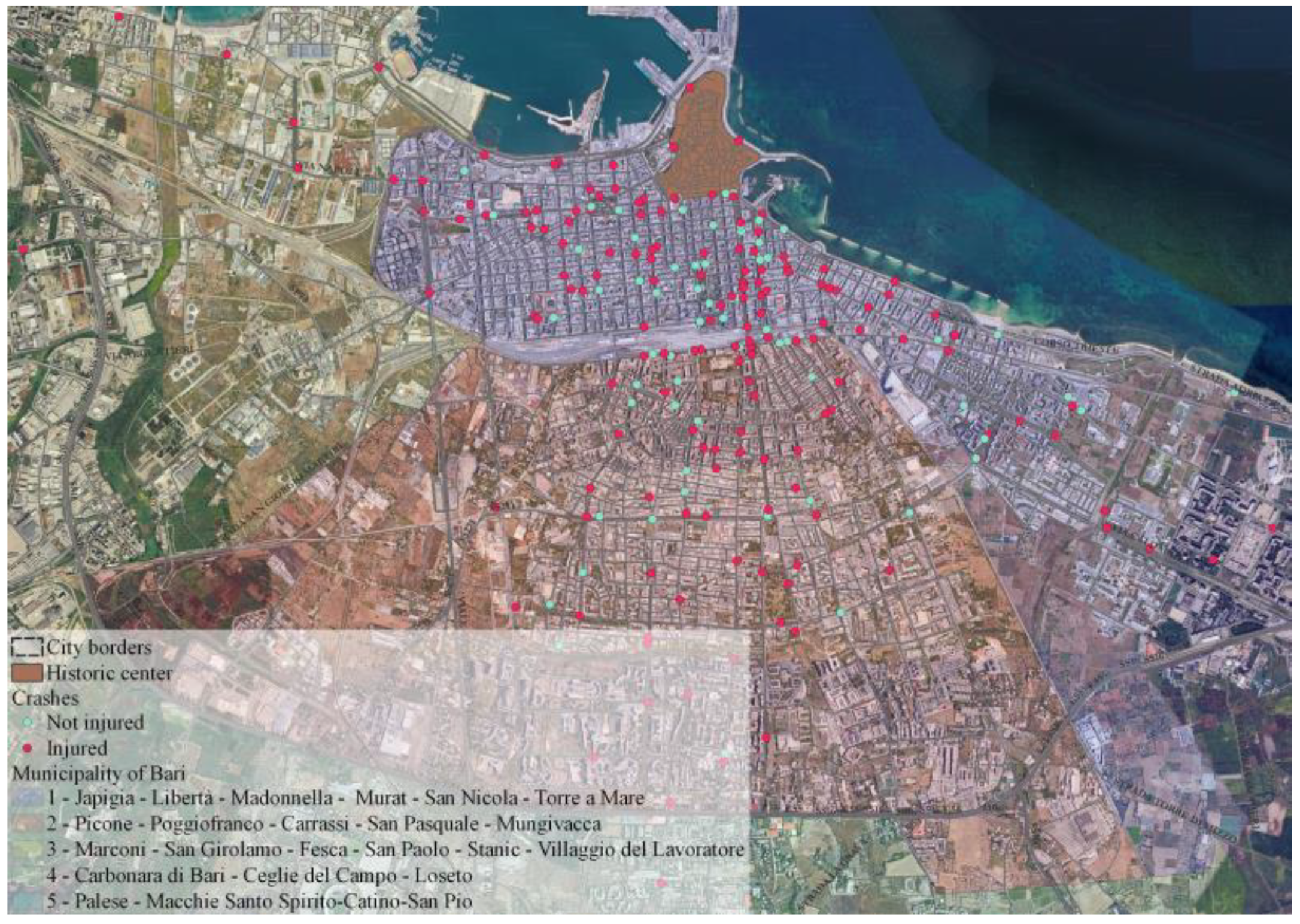
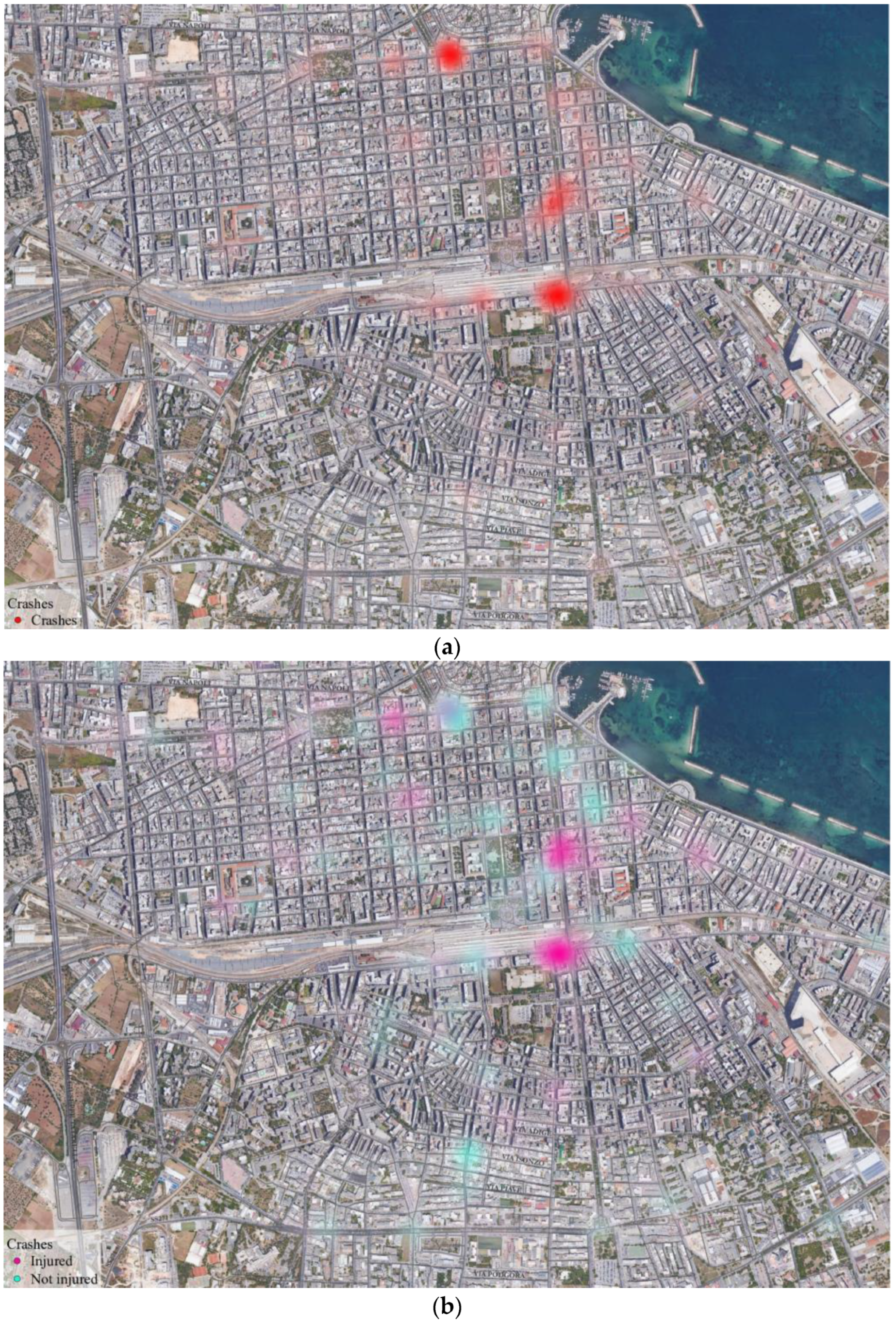
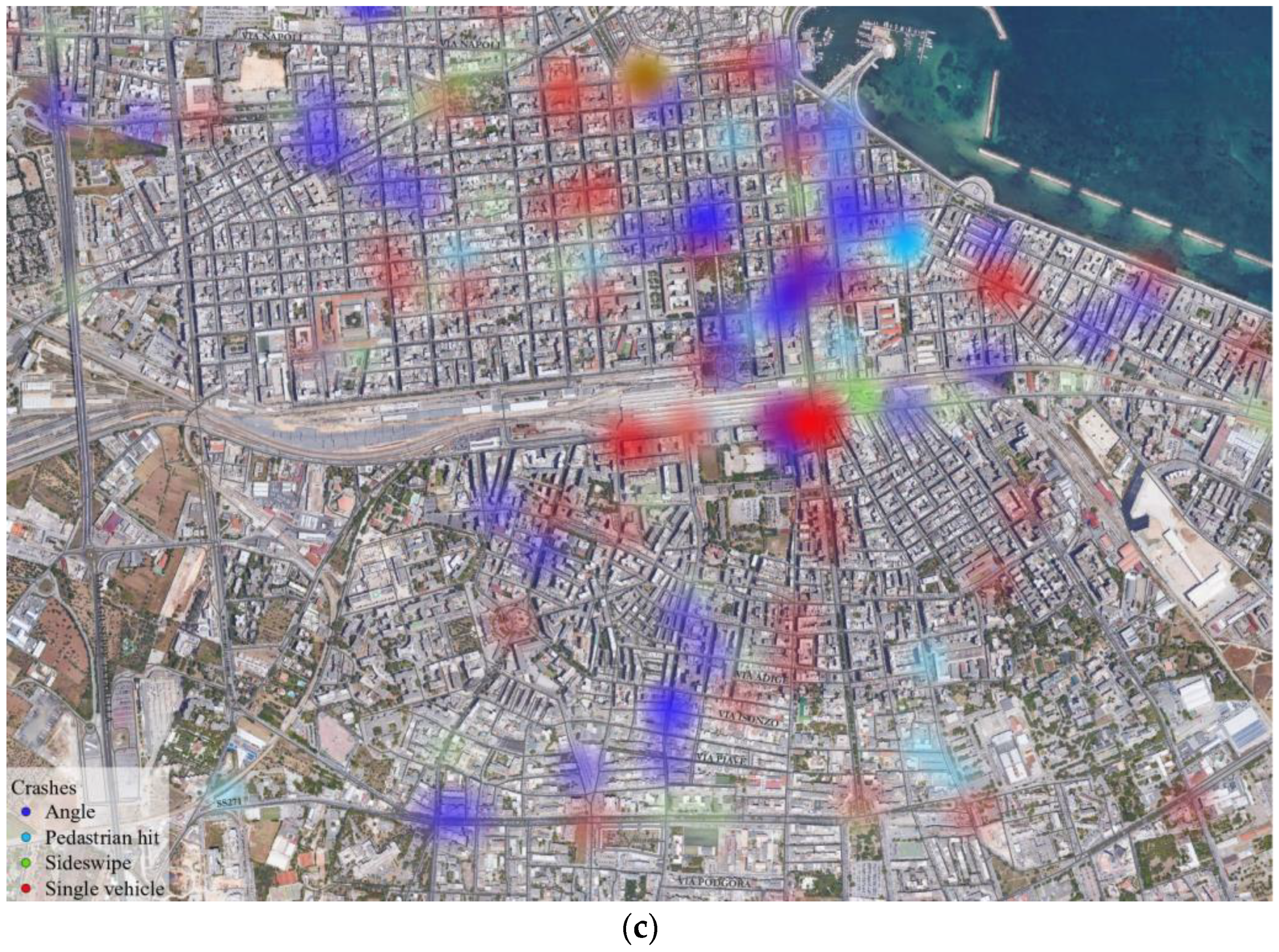
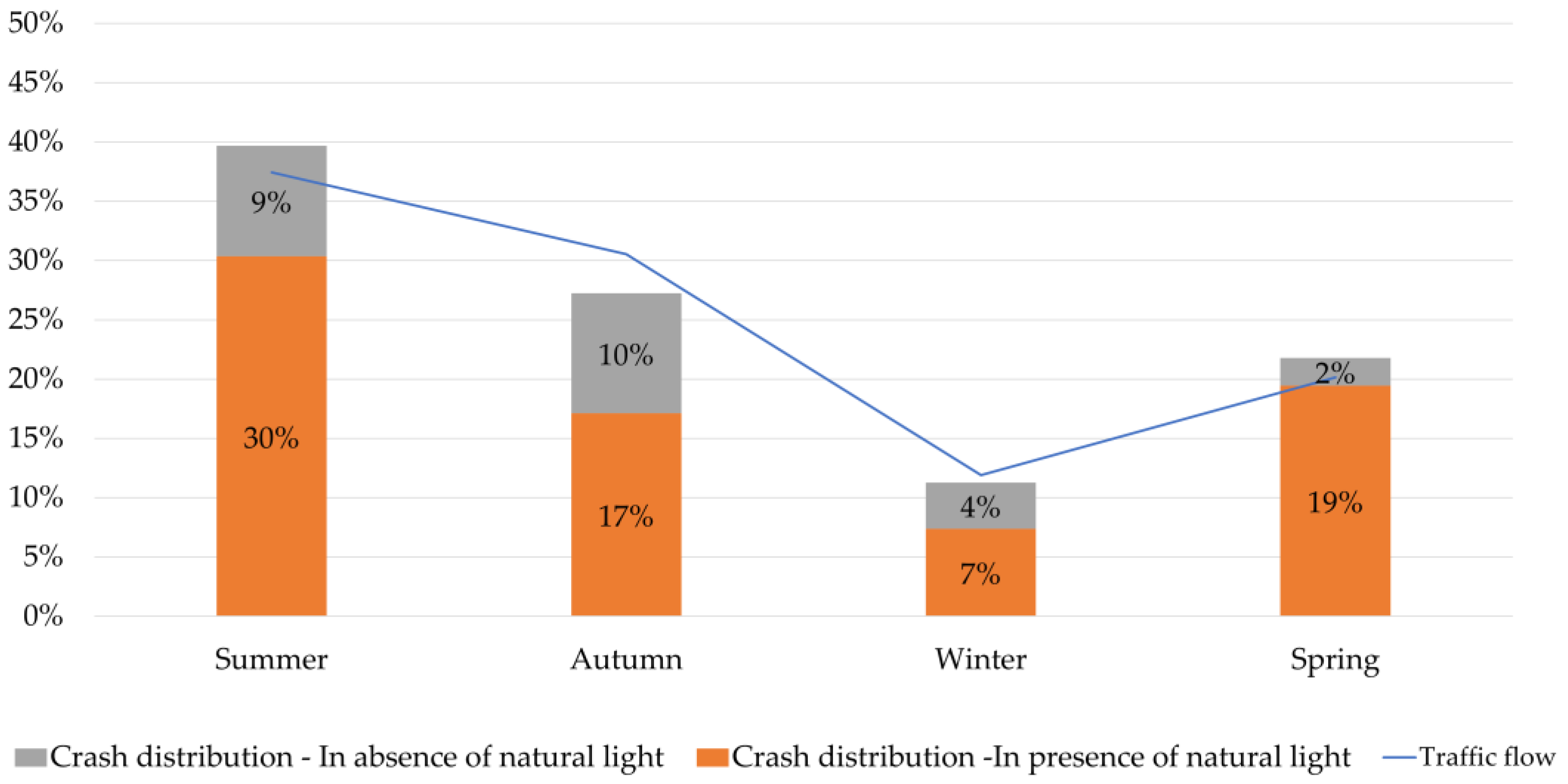
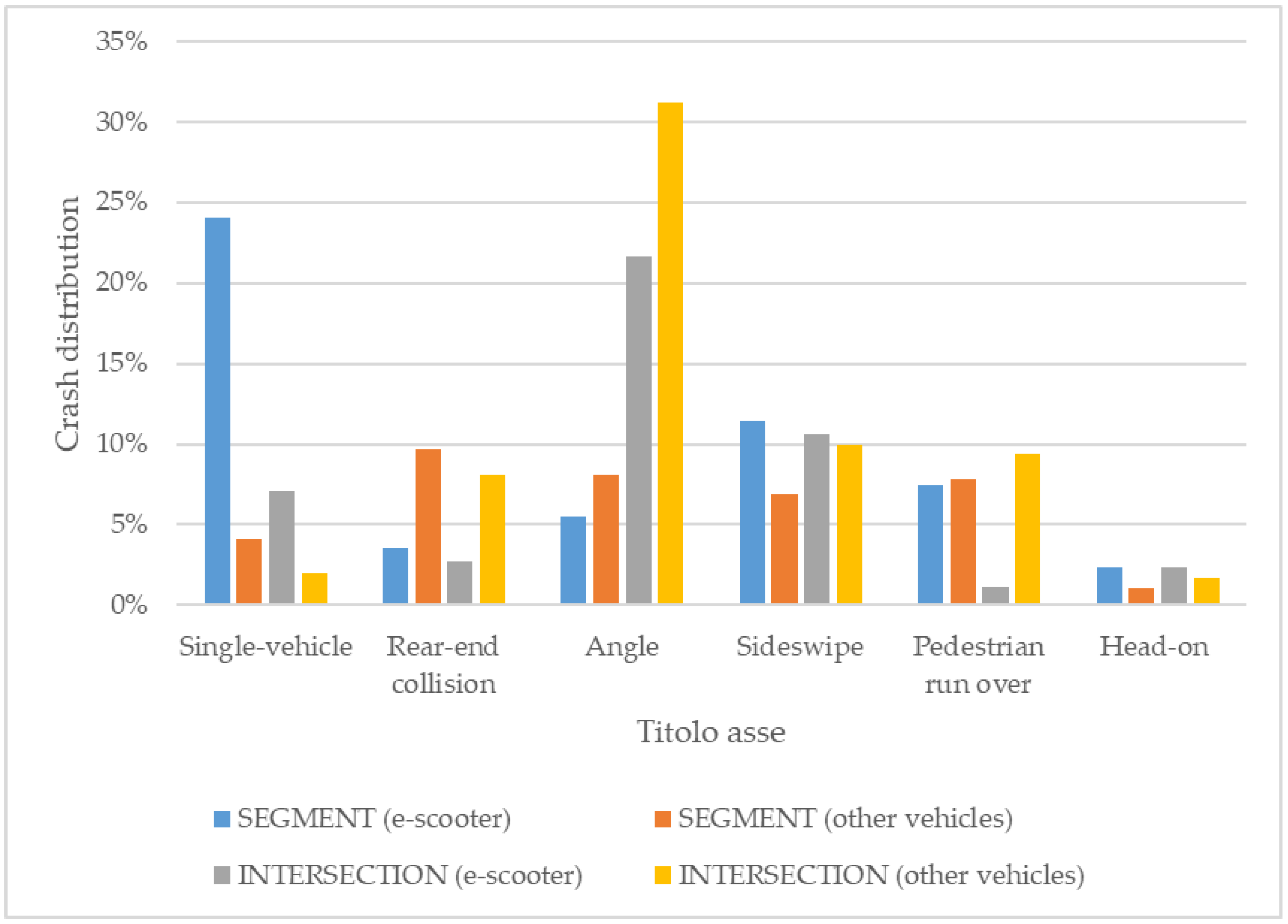
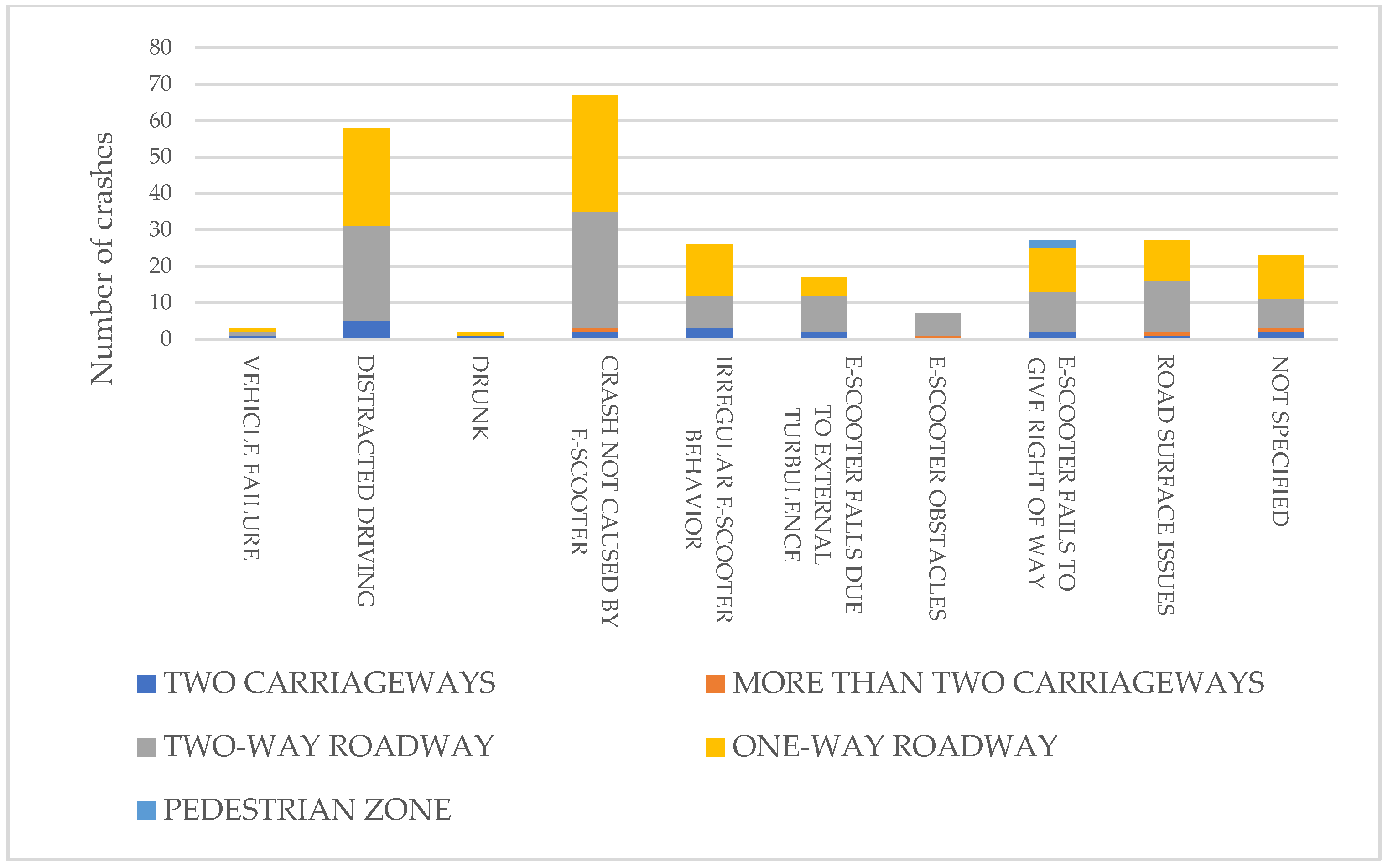
| Year | Number of Crashes |
|---|---|
| 2020 (from July to December) | 41 |
| 2021 (from January to December) | 118 |
| 2022 (from January to November) | 98 |
| Total | 257 |
| Crash-Related Variable | Number | Percentage | |
|---|---|---|---|
| Severity | |||
| Fatal | 0 | 0% | |
| With injuries to involved users No injuries | 181 76 | 70% 30% | |
| Road type | |||
| Undivided one-way Undivided one-way with cycle path Undivided one-way w/o cycle path | 115 9 106 | 45% 4% 41% | |
| Undivided two-way Undivided two-way with cycle path Undivided two-way w/o cycle path | 117 28 89 | 45% 11% 34% | |
| Divided multi-lane Divided multi-lane with cycle path Divided multi-lane w/o cycle path | 19 5 14 | 7% 2% 5% | |
| Three+ Carriageways Three+ Carriageways with cycle path Three+ Carriageways without cycle path | 4 1 3 | 2% 0% 1% | |
| Pedestrian zone | 2 | 1% | |
| Motor-vehicle traffic conditions | |||
| Peak hours (7 a.m.–9 a.m., 1 p.m.–3 p.m.) | 48 | 19% | |
| Night hours (10 p.m.–6 a.m.) Other calm hours | 26 183 | 10% 71% | |
| Season | |||
| Summer | 102 | 40% | |
| Autumn | 70 | 27% | |
| Winter | 29 | 11% | |
| Spring | 56 | 22% | |
| Lighting conditions | |||
| In presence of natural light | 191 | 74% | |
| In absence of light | 66 | 26% | |
| Road elements | |||
| Signalized intersection | 27 | 11% | |
| Unsignalized intersection | 80 | 31% | |
| Curve | 2 | 1% | |
| Segment (including bridges, tunnels) | 135 | 52% | |
| Roundabout | 9 | 4% | |
| Bridge | 4 | 2% | |
| Crash type | |||
| Single-vehicle | 82 | 31% | |
| Rear-end | 16 | 6% | |
| Angle | 69 | 27% | |
| Sideswipe | 56 | 22% | |
| Pedestrian hit | 22 | 9% | |
| Head-on | 12 | 5% | |
| Pavement conditions | |||
| Dry | 246 | 96% | |
| Wet/Slippery | 11 | 4% | |
| E-scooter driver age | |||
| <18 | 24 | 9% | |
| 18–30 | 96 | 37% | |
| 31–40 | 42 | 16% | |
| >40 | 49 | 19% | |
| Unspecified | 46 | 18% | |
| E-scooter driver sex | |||
| Man | 154 | 60% | |
| Woman | 57 | 22% | |
| Unspecified | 46 | 18% | |
| Crashes occurring with a passenger on board the e-scooter | |||
| Yes | 12 | 5% | |
| No | 245 | 95% | |
| Private or shared e-scooter | |||
| Shared | 71 | 28% | |
| Private | 158 | 72% | |
| Unspecified | 28 | 11% | |
| Crash dynamics and/or contributing factors | |||
| Crash not caused by the e-scooter | 67 | 26% | |
| E-scooter failure | 3 | 1% | |
| Distracted e-scooter driving | 58 | 23% | |
| Drunk e-scooter driving | 2 | 1% | |
| Irregular e-scooter behavior | 26 | 10% | |
| E-scooter falls due to external turbulence | 17 | 7% | |
| Obstructing parked e-scooter | 7 | 3% | |
| E-scooter fails to give right of way | 27 | 11% | |
| Road surface issues | 27 | 11% | |
| Unspecified | 23 | 9% | |
| Cycle path | |||
| Crash occurring on a cycle path | 25 | 10% | |
| Crash not occurring on a cycle path | 232 | 90% | |
| Cycle path present | 22 | 9% | |
| No cycle paths | 210 | 81% | |
| Explanatory Variable | Coeff. Estimate | Std. Error | z Value | p-Value |
|---|---|---|---|---|
| Day hour: peak hour (ref.: calm hour) | 0.617 | 0.758 | 1.51 | 0.131 |
| Day hour: night hours (ref.: calm hour) | 1.451 | 2.639 | 2.35 | 0.019 |
| Crash type: angle (ref.: single-vehicle) | −0.607 | 0.256 | −1.29 | 0.196 |
| Crash type: sideswipe (ref.: single-vehicle) | −0.384 | 0.324 | −0.81 | 0.420 |
| Crash type: pedestrian hit (ref.: single-vehicle) | 2.141 | 7.572 | 2.40 | 0.016 |
| Crash type: other (ref.: single-vehicle) | −1.001 | 0.210 | −1.76 | 0.079 |
| Age: <18 (ref.: 18–30) | 0.936 | 1.503 | 1.59 | 0.113 |
| Age: 31–40 (ref.: 18–30) | 0.593 | 0.845 | 1.27 | 0.205 |
| Age: >40 (ref.: 18–30) | 0.350 | 0.622 | 0.80 | 0.424 |
| Age: Unspecified (ref.: 18–30) | −0.069 | 0.070 | −3.17 | 0.002 |
| Sharing: sharing (ref.: private) | −0.235 | 0.290 | −0.64 | 0.522 |
| Sharing: Unspecified (ref.: private) | 2.247 | 8.452 | 2.52 | 0.012 |
| Dynamics: irregular e-scooter behavior (ref: Crash not caused by the e-scooter) | 0.143 | 0.445 | 0.37 | 0.711 |
| Dynamics: other (ref: Crash not caused by the e-scooter) | 0.848 | 1.781 | 1.11 | 0.266 |
| Dynamics: Road surface issues (ref: Crash not caused by the e-scooter) | 1.601 | 4.334 | 1.83 | 0.067 |
| Likelihood ratio test (reference: null model): χ2(15) = 43.22, p < 0.001, R2 = 0.1385 | ||||
| Explanatory Variable – Crash Type | Coeff. Estimate | Std. Error | z Value | p-Value |
|---|---|---|---|---|
| Crash type: angle (base outcome: single-vehicle) | ||||
| Road type (ref: undivided two-way) | ||||
| Undivided one-way | 0.717 | 0.409 | 1.75 | 0.080 |
| Divided multi-lane | 0.619 | 0.771 | 0.02 | 0.981 |
| Pedestrian zone | 1.136 | 88,084.55 | 0.00 | 1.000 |
| Day hour (ref.: calm hour) | ||||
| Peak hours | −0.146 | 0.499 | −0.29 | 0.769 |
| Night hours | −0.566 | 0.617 | −0.92 | 0.359 |
| Road geometry (ref.: segment) | ||||
| Unsignalized intersection | 2.793 | 0.473 | 5.90 | 0.000 |
| Signalized intersection | 2.626 | 0.687 | 3.82 | 0.000 |
| Roundabout | 2.106 | 0.960 | 2.19 | 0.028 |
| Age (ref.: 18–30) | ||||
| <18 | 1.153 | 0.905 | 1.27 | 0.203 |
| 31–40 | 0.271 | 0.538 | 0.50 | 0.614 |
| >40 | −0.563 | 0.551 | −1.02 | 0.307 |
| Unspecified | −0.562 | 0.587 | −0.96 | 0.338 |
| Crash type: sideswipe (base outcome: single-vehicle) | ||||
| Road type (ref: undivided two-way) | ||||
| Undivided one-way | 0.297 | 0.391 | 0.76 | 0.447 |
| Divided multi-lane | 0.274 | 0.696 | 0.39 | 0.693 |
| Pedestrian zone | −0.133 | 89,385.11 | 0.00 | 1.000 |
| Day hour (ref.: calm hour) | ||||
| Peak hours | −0.160 | 0.484 | −0.33 | 0.741 |
| Night hours | −1.301 | 0.731 | −1.78 | 0.075 |
| Road geometry (ref.: segment) | ||||
| Unsignalized intersection | 1.222 | 0.470 | 2.60 | 0.009 |
| Signalized intersection | 1.318 | 0.684 | 1.93 | 0.054 |
| Roundabout | 0.649 | 1.054 | 0.62 | 0.538 |
| Age (ref.: 18–30) | ||||
| <18 | 1.357 | 0.900 | 1.51 | 0.132 |
| 31–40 | −0.166 | 0.518 | −0.32 | 0.748 |
| >40 | −0.363 | 0.499 | −0.73 | 0.466 |
| Unspecified | −0.543 | 0.578 | −0.94 | 0.347 |
| Crash type: pedestrian hit (base outcome: single-vehicle) | ||||
| Road (ref: undivided two-way) | ||||
| Undivided one-way | 0.038 | 0.580 | 0.07 | 0.947 |
| Divided multi-lane | 0.511 | 1.011 | 0.51 | 0.613 |
| Pedestrian zone | 22.995 | 60,640.19 | 0.00 | 1.000 |
| Day hour (ref.: calm hour) | ||||
| Peak hours | −0.485 | 0.766 | −0.63 | 0.527 |
| Night hours | −14.041 | 638.874 | −0.02 | 0.982 |
| Road geometry (ref.: segment) | ||||
| Unsignalized intersection | −0.080 | 0.777 | −0.10 | 0.918 |
| Signalized intersection | −13.587 | 509.270 | −0.03 | 0.979 |
| Roundabout | −13.521 | 938.137 | −0.01 | 0.989 |
| Age (ref.: 18–30) | ||||
| <18 | 1.107 | 1.369 | 0.81 | 0.419 |
| 31–40 | −1.371 | 1.118 | −1.23 | 0.220 |
| >40 | −1.528 | 1.121 | −1.36 | 0.173 |
| Unspecified | 1.300 | 0.626 | 2.08 | 0.038 |
| Crash type: other (base outcome: single-vehicle) | ||||
| Road (ref: undivided two-way) | ||||
| Undivided one-way | −0.700 | 0.544 | −1.29 | 0.198 |
| Divided multi-lane | 0.448 | 0.730 | 0.61 | 0.540 |
| Pedestrian zone | −0.400 | 118,229.3 | 0.00 | 1.000 |
| Day hour (ref.: calm hour) | ||||
| Peak hours | 0.457 | 0.571 | 0.80 | 0.423 |
| Night hours | 0.262 | 0.717 | 0.37 | 0.714 |
| Road geometry (ref.: segment) | ||||
| Unsignalized intersection | 0.871 | 0.587 | 1.49 | 0.138 |
| Signalized intersection | 1.330 | 0.778 | 1.71 | 0.087 |
| Roundabout | 0.717 | 1.294 | 0.55 | 0.579 |
| Age (ref.: 18–30) | ||||
| <18 | 1.251 | 1.004 | 1.25 | 0.213 |
| 31–40 | −0.636 | 0.739 | −0.86 | 0.389 |
| >40 | 0.161 | 0.595 | 0.27 | 0.787 |
| Unspecified | −0.830 | 0.800 | −1.04 | 0.299 |
| Likelihood ratio test (reference: null model): χ2(48) = 123.43, p < 0.001, R2 = 0.1599 | ||||
Disclaimer/Publisher’s Note: The statements, opinions and data contained in all publications are solely those of the individual author(s) and contributor(s) and not of MDPI and/or the editor(s). MDPI and/or the editor(s) disclaim responsibility for any injury to people or property resulting from any ideas, methods, instructions or products referred to in the content. |
© 2024 by the authors. Licensee MDPI, Basel, Switzerland. This article is an open access article distributed under the terms and conditions of the Creative Commons Attribution (CC BY) license (https://creativecommons.org/licenses/by/4.0/).
Share and Cite
Longo, P.; Berloco, N.; Coropulis, S.; Intini, P.; Ranieri, V. Analysis of E-Scooter Crashes in the City of Bari. Infrastructures 2024, 9, 63. https://doi.org/10.3390/infrastructures9030063
Longo P, Berloco N, Coropulis S, Intini P, Ranieri V. Analysis of E-Scooter Crashes in the City of Bari. Infrastructures. 2024; 9(3):63. https://doi.org/10.3390/infrastructures9030063
Chicago/Turabian StyleLongo, Paola, Nicola Berloco, Stefano Coropulis, Paolo Intini, and Vittorio Ranieri. 2024. "Analysis of E-Scooter Crashes in the City of Bari" Infrastructures 9, no. 3: 63. https://doi.org/10.3390/infrastructures9030063






